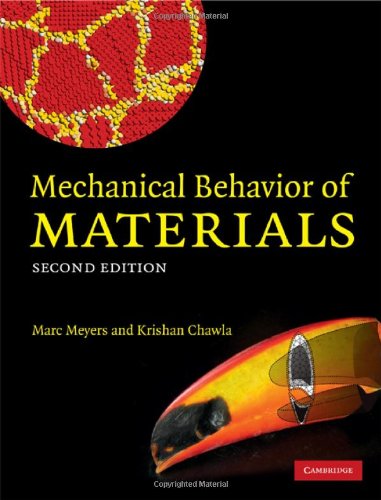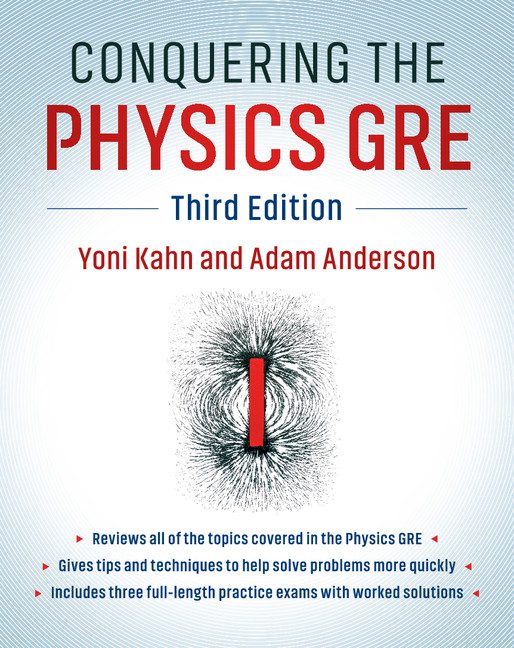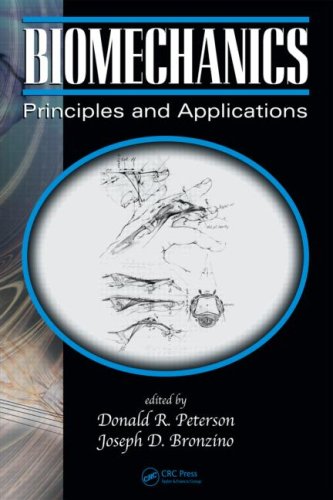Marc André Meyers, Krishan Kumar Chawla0521866758, 9780521866750
Table of contents :
Cover……Page 1
Half-title……Page 3
Title……Page 5
Copyright……Page 6
Contents……Page 9
Preface to the First Edition……Page 19
Preface to the Second Edition……Page 23
A Note to the Reader……Page 25
1.1 Introduction……Page 27
1.2 Monolithic, Composite, and Hierarchical Materials……Page 29
1.3 Structure of Materials……Page 41
1.3.1 Crystal Structures……Page 42
1.3.2 Metals……Page 45
1.3.3 Ceramics……Page 51
1.3.4 Glasses……Page 56
Chemical Structure……Page 57
Types of Polymers……Page 58
Thermosetting Polymers and Thermoplastics……Page 59
Degree of Crystallinity……Page 61
Molecular Weight and Distribution……Page 62
Quasi Crystals……Page 64
1.3.6 Liquid Crystals……Page 65
1.3.7 Biological Materials and Biomaterials……Page 66
1.3.8 Porous and Cellular Materials……Page 70
1.3.9 Nano- and Microstructure of Biological Materials……Page 71
Actin and Myosin……Page 78
Cellulose……Page 79
Silk……Page 80
1.3.10 The Sponge Spicule: An Example of a Biological Material……Page 82
1.3.11 Active (or Smart) Materials……Page 83
1.3.12 Electronic Materials……Page 84
1.3.13 Nanotechnology……Page 86
1.4 Strength of Real Materials……Page 87
Ceramics……Page 90
Exercises……Page 91
2.1 Introduction……Page 97
2.2 Longitudinal Stress and Strain……Page 98
2.3 Strain Energy (or Deformation Energy) Density……Page 103
2.4 Shear Stress and Strain……Page 106
2.5 Poisson’s Ratio……Page 109
2.6 More Complex States of Stress……Page 111
2.7 Graphical Solution of a Biaxial State of Stress: the Mohr Circle……Page 115
2.8 Pure Shear: Relationship between G and E……Page 121
2.9 Anisotropic Effects……Page 122
2.10 Elastic Properties of Polycrystals……Page 133
2.11 Elastic Properties of Materials……Page 136
2.11.2 Elastic Properties of Ceramics……Page 137
2.11.3 Elastic Properties of Polymers……Page 142
2.11.4 Elastic Constants of Unidirectional Fiber Reinforced Composite……Page 143
2.12 Viscoelasticity……Page 146
2.12.1 Storage and Loss Moduli……Page 150
2.13 Rubber Elasticity……Page 152
2.14 Mooney–Rivlin Equation……Page 157
2.15.1 Blood Vessels……Page 160
Nonlinear Elasticity……Page 161
Residual Stresses……Page 162
2.15.2 Articular Cartilage……Page 163
2.15.3 Mechanical Properties at the Nanometer Level……Page 166
2.16 Elastic Properties of Electronic Materials……Page 169
2.17 Elastic Constants and Bonding……Page 171
Exercises……Page 181
3.1 Introduction……Page 187
3.2 Plastic Deformation in Tension……Page 189
3.2.1 Tensile Curve Parameters……Page 197
3.2.2 Necking……Page 198
3.2.3 Strain Rate Effects……Page 202
3.3 Plastic Deformation in Compression Testing……Page 209
3.4 The Bauschinger Effect……Page 213
3.5.1 Stress–Strain Curves……Page 214
3.5.2 Glassy Polymers……Page 215
3.5.3 Semicrystalline Polymers……Page 216
3.5.4 Viscous Flow……Page 217
3.5.5 Adiabatic Heating……Page 218
3.6 Plastic Deformation of Glasses……Page 219
3.6.1 Microscopic Deformation Mechanisms……Page 221
3.6.2 Temperature Dependence and Viscosity……Page 223
3.7 Flow, Yield, and Failure Criteria……Page 225
3.7.2 Maximum-Shear-Stress Criterion (Tresca)……Page 226
3.7.4 Graphical Representation and Experimental Verification of Rankine, Tresca, and von Mises Criteria……Page 227
3.7.5 Failure Criteria for Brittle Materials……Page 231
Griffith Failure Criterion……Page 232
McClintock–Walsh Criterion……Page 233
3.7.6 Yield Criteria for Ductile Polymers……Page 235
Quadratic Interaction Criterion……Page 237
Transverse (Tensile and Compressive) Tests……Page 238
3.7.8 Yield and Failure Criteria for Other Anisotropic Materials……Page 239
3.8 Hardness……Page 240
Brinell Hardness Test……Page 242
Rockwell Hardness Test……Page 244
Vickers (or Diamond Pyramid) Hardness Test……Page 246
3.8.2 Microindentation Tests……Page 247
3.8.3 Nanoindentation……Page 251
3.9 Formability: Important Parameters……Page 255
3.9.1 Plastic Anisotropy……Page 257
3.9.2 Punch–Stretch Tests and Forming-Limit Curves (or Keeler–Goodwin Diagrams)……Page 258
3.10 Muscle Force……Page 263
3.11 Mechanical Properties of Some Biological Materials……Page 267
Formability……Page 271
Exercises……Page 272
4.1 Introduction……Page 277
4.2 Theoretical Shear Strength……Page 278
4.3 Atomic or Electronic Point Defects……Page 280
4.3.1 Equilibrium Concentration of Point Defects……Page 282
4.3.2 Production of Point Defects……Page 285
4.3.3 Effect of Point Defects on Mechanical Properties……Page 286
4.3.4 Radiation Damage……Page 287
4.3.5 Ion Implantation……Page 291
4.4 Line Defects……Page 292
4.4.1 Experimental Observation of Dislocations……Page 296
Dislocation Loops……Page 299
Movement of Dislocations……Page 300
4.4.3 Stress Field Around Dislocations……Page 301
4.4.4 Energy of Dislocations……Page 304
4.4.5 Force Required to Bow a Dislocation……Page 308
Peach–Koehler equation……Page 309
Dislocations in Face-Centered Cubic Crystals……Page 310
Dislocations in Body-Centered Cubic Crystals……Page 317
4.4.7 Dislocations in Ceramics……Page 319
4.4.8 Sources of Dislocations……Page 324
4.4.9 Dislocation Pileups……Page 328
4.4.10 Intersection of Dislocations……Page 330
4.4.11 Deformation Produced by Motion of Dislocations (Orowan’s Equation)……Page 332
4.4.12 The Peierls–Nabarro Stress……Page 335
4.4.13 The Movement of Dislocations: Temperature and Strain Rate Effects……Page 336
4.4.14 Dislocations in Electronic Materials……Page 339
Point Defects……Page 342
Exercises……Page 343
5.2 Grain Boundaries……Page 347
5.2.1 Tilt and Twist Boundaries……Page 352
5.2.2 Energy of a Grain Boundary……Page 354
5.2.3 Variation of Grain-Boundary Energy with Misorientation……Page 356
5.2.4 Coincidence Site Lattice (CSL) Boundaries……Page 358
5.2.6 Grain-Boundary Dislocations and Ledges……Page 360
5.3 Twinning and Twin Boundaries……Page 362
5.3.1 Crystallography and Morphology……Page 363
5.3.2 Mechanical Effects……Page 367
5.4 Grain Boundaries in Plastic Deformation (Grain-Size Strengthening)……Page 371
5.4.1 Hall–Petch Theory……Page 374
5.4.2 Cottrell’s Theory……Page 375
5.4.3 Li’s Theory……Page 376
5.4.4 Meyers–Ashworth Theory……Page 377
5.5 Other Internal Obstacles……Page 379
5.6 Nanocrystalline Materials……Page 381
5.7 Volumetric or Tridimensional Defects……Page 384
5.8 Imperfections in Polymers……Page 387
Exercises……Page 390
6.1 Introduction……Page 395
6.2.1 Stereographic Projections……Page 399
6.2.2 Stress Required for Slip……Page 400
6.2.3 Shear Deformation……Page 406
6.2.4 Slip in Systems and Work-Hardening……Page 407
6.3 Work-Hardening in Polycrystals……Page 410
6.3.1 Taylor’s Theory……Page 412
6.3.3 Kuhlmann–Wilsdorf’s Theory……Page 414
6.4 Softening Mechanisms……Page 418
6.5 Texture Strengthening……Page 421
Exercises……Page 425
7.1 Introduction……Page 430
7.2 Theorectical Tensile Strength……Page 432
7.3.2 Stress Concentration Factor……Page 435
7.4 Griffith Criterion……Page 442
7.5 Crack Propagation with Plasticity……Page 445
7.6 Linear Elastic Fracture Mechanics……Page 447
7.6.1 Fracture Toughness……Page 448
7.6.3 Crack-Tip Separation Modes……Page 449
7.6.4 Stress Field in an Isotropic Material in the Vicinity of a Crack Tip……Page 450
7.6.5 Details of the Crack-Tip Stress Field in Mode I……Page 451
7.6.6 Plastic-Zone Size Correction……Page 454
7.6.7 Variation in Fracture Toughness with Thickness……Page 457
7.7.1 Crack Extension Force G……Page 460
7.7.2 Crack Opening Displacement……Page 463
7.7.3 J Integral……Page 466
7.7.4 R Curve……Page 469
7.7.5 Relationships among Different Fracture Toughness Parameters……Page 470
7.8 Importance of Klc in Practice……Page 471
7.9 Post-Yield Fracture Mechanics……Page 474
7.10 Statistical Analysis of Failure Strength……Page 475
Appendix: Stress Singularity at Crack Tip……Page 484
Exercises……Page 486
8.1 Introduction……Page 492
8.2.1 Crack Nucleation……Page 494
8.2.2 Ductile Fracture……Page 495
Fracture by Void Nucleation, Growth, and Coalescence……Page 500
8.2.3 Brittle, or Cleavage, Fracture……Page 506
8.3.1 Microstructural Aspects……Page 513
8.3.2 Effect of Grain Size on Strength of Ceramics……Page 520
8.3.3 Fracture of Ceramics in Tension……Page 522
8.3.4 Fracture in Ceramics Under Compression……Page 525
8.3.5 Thermally Induced Fracture in Ceramics……Page 530
8.4.1 Brittle Fracture……Page 533
8.4.2 Crazing and Shear Yielding……Page 534
8.4.3 Fracture in Semicrystalline and Crystalline Polymers……Page 538
8.4.4 Toughness of Polymers……Page 539
8.5 Fracture and Toughness of Biological Materials……Page 543
Exercises……Page 547
9.2 Impact Testing……Page 551
9.2.1 Charpy Impact Test……Page 552
9.2.2 Drop-Weight Test……Page 555
9.2.3 Instrumented Charpy Impact Test……Page 557
9.3 Plane-Strain Fracture Toughness Test……Page 558
9.4 Crack Opening Displacement Testing……Page 563
9.5 j-Integral Testing……Page 564
9.6 Flexure Test……Page 566
9.6.1 Three-Point Bend Test……Page 567
9.6.2 Four-Point Bending……Page 568
9.6.3 Interlaminar Shear Strength Test……Page 569
9.7 Fracture Toughness Testing of Brittle Materials……Page 571
9.7.1 Chevron Notch Test……Page 573
9.7.2 Indentation Methods for Determining Toughness……Page 575
9.8 Adhesion of Thin Films to Substrates……Page 578
Exercises……Page 579
10.1 Introduction……Page 584
10.2 Solid-Solution Strengthening……Page 585
10.2.1 Elastic Interaction……Page 586
10.3 Mechanical Effects Associated with Solid Solutions……Page 590
10.3.1 Well-Defined Yield Point in the Stress–Strain Curves……Page 591
10.3.2 Plateau in the Stress–Strain Curve and Luders Band……Page 592
10.3.3 Strain Aging……Page 593
10.3.4 Serrated Stress–Strain Curve……Page 594
10.3.5 Snoek Effect……Page 595
10.3.6 Blue Brittleness……Page 596
10.4 Precipitation- and Dispersion-Hardening……Page 597
10.5 Dislocation–Precipitate Interaction……Page 605
10.6 Precipitation in Microalloyed Steels……Page 611
Suggested Reading……Page 616
Exercises……Page 617
11.2 Structures and Morphologies of Martensite……Page 620
11.3 Strength of Martensite……Page 626
11.4 Mechanical Effects……Page 629
11.5 Shape-Memory Effect……Page 634
11.6 Martensitic Transformation in Ceramics……Page 640
Suggested Reading……Page 644
Exercises……Page 645
12.2 Silicides……Page 647
12.3 Ordered Intermetallics……Page 648
12.3.1 Dislocation Structures in Ordered Intermetallics……Page 650
12.3.2 Effect of Ordering on Mechanical Properties……Page 654
12.3.3 Ductility of Intermetallics……Page 660
Microalloying……Page 661
Processing-induced microstructural control……Page 662
Composite route……Page 663
Environmental effects in intermetallics……Page 664
12.4.2 Modeling of the Mechanical Response……Page 665
Elastic Region……Page 667
Plastic Plateau……Page 669
Densification……Page 670
12.4.4 Syntactic Foam……Page 671
12.4.5 Plastic Behavior of Porous Materials……Page 672
Exercises……Page 676
13.1 Introduction……Page 679
13.2 Correlation and Extrapolation Methods……Page 685
13.3 Fundamental Mechanisms Responsible for Creep……Page 691
13.4 Diffusion Creep………Page 692
13.5 Dislocation (or Power Law) Creep………Page 696
13.6 Dislocation Glide………Page 699
13.7 Grain-Boundary Sliding……Page 701
13.8 Deformation-Mechanism (Weertman–Ashby) Maps……Page 702
13.9 Creep-Induced Fracture……Page 704
13.10 Heat-Resistant Materials……Page 707
13.11 Creep in Polymers……Page 714
13.12 Diffusion-Related Phenomena in Electronic Materials……Page 721
13.13 Superplasticity……Page 723
Exercises……Page 731
14.1 Introduction……Page 739
14.2 Fatigue Parameters and S-N (Wöhler) Curves……Page 740
14.3 Fatigue Strength or Fatigue Life……Page 742
14.4 Effect of Mean Stress on Fatigue Life……Page 745
14.6 Cumulative Damage and Life Exhaustion……Page 747
14.7.1 Fatigue Crack Nucleation……Page 751
14.7.2 Fatigue Crack Propagation……Page 756
14.8 Linear Elastic Fracture Mechanics Applied to Fatigue……Page 761
14.8.1 Fatigue of Biomaterials……Page 770
14.9 Hysteretic Heating in Fatigue……Page 772
14.11 Fatigue Crack Closure……Page 774
14.12 The Two-Parameter Approach……Page 775
14.13 The Short-Crack Problem in Fatigue……Page 776
14.14.2 Rotating Bending Machine……Page 777
14.14.4 Nonconventional Fatigue Testing……Page 779
14.14.5 Servohydraulic Machines……Page 781
14.14.6 Low-Cycle Fatigue Tests……Page 782
14.14.7 Fatigue Crack Propagation Testing……Page 783
Suggested Reading……Page 784
Exercises……Page 785
15.2 Types of Composites……Page 791
15.3 Important Reinforcements and Matrix Materials……Page 793
15.3.1 Microstructural Aspects and Importance of the Matrix……Page 795
15.4 Interfaces in Composites……Page 796
15.4.1 Crystallographic Nature of the Fiber–Matrix Interface……Page 797
15.4.2 Interfacial Bonding in Composites……Page 798
15.4.3 Interfacial Interactions……Page 799
15.5 Properties of Composites……Page 800
15.5.2 Elastic Moduli……Page 801
15.5.3 Strength……Page 806
15.5.4 Anisotropic Nature of Fiber Reinforced Composites……Page 809
15.5.6 Toughness……Page 811
15.6 Load Transfer from Matrix to Fiber……Page 814
15.6.1 Fiber and Matrix Elastic……Page 815
15.6.2 Fiber Elastic and Matrix Plastic……Page 818
15.7 Fracture in Composites……Page 820
15.7.1 Single and Multiple Fracture……Page 821
15.7.2 Failure Modes in Composites……Page 822
15.8.2 Anisotropy……Page 825
15.8.3 Shear Coupling……Page 827
15.8.4 Statistical Variation in Strength……Page 828
15.10.1 Aerospace Applications……Page 829
15.10.2 Nonaerospace Applications……Page 830
15.11 Laminated Composites……Page 832
Suggested Reading……Page 835
Exercises……Page 836
16.2 Electrochemical Nature of Corrosion in Metals……Page 841
16.2.1 Galvanic Corrosion……Page 842
16.2.3 Crevice corrosion……Page 843
16.2.5 Intergranular Corrosion……Page 844
16.3 Oxidation of Metals……Page 845
16.4.1 Stress Corrosion Cracking (SCC)……Page 846
Effect of Material Variables on SCC……Page 849
16.4.2 Hydrogen Damage in Metals……Page 850
Theories of Hydrogen Damage……Page 851
Pressure theory……Page 853
Surface Energy……Page 854
Hydride Formation……Page 855
16.4.3 Liquid and Solid Metal Embrittlement……Page 856
16.5 Environmental Effects in Polymers……Page 857
16.5.2 Swelling……Page 858
16.5.3 Oxidation……Page 859
16.5.4 Radiation Damage……Page 860
16.5.5 Environmental Crazing……Page 861
16.6 Environmental Effects in Ceramics……Page 862
16.6.1 Oxidation of Ceramics……Page 865
Exercises……Page 866
Appendixes……Page 869
Index……Page 877







Reviews
There are no reviews yet.